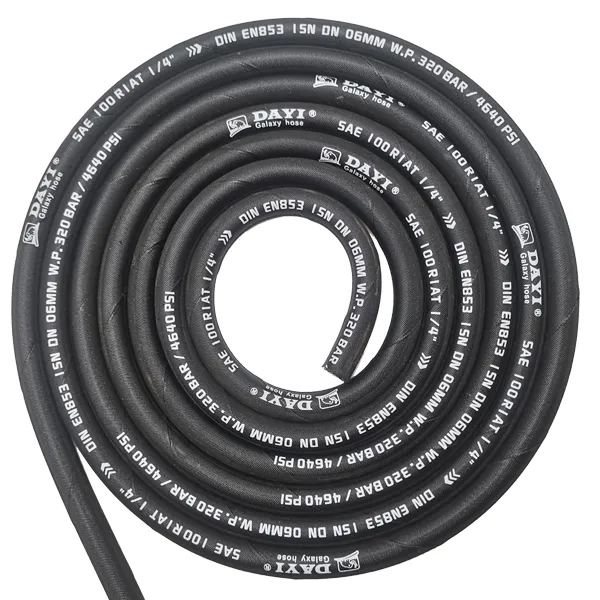335345435
Jan. . 26, 2025 15:12 Zurück zur Liste
Mastering Hydraulic Systems: The Essential Guide to hydraulic hose Solutions
A Hydraulikschlauch is an essential component in hydraulic systems, responsible for channeling pressurized fluid that powers various machinery in industries such as construction, manufacturing, and agriculture. The right Hydraulikschlauch ensures smooth operations, preventing downtime. This article dives into critical aspects of hydraulic hose maintenance, installation, and cost considerations, providing you with the knowledge to optimize your hydraulic systems effectively.

Troubleshooting Your Hydraulikschlauch: Identifying Common Problems
Like all mechanical parts, Hydraulikschlauchs can experience wear and tear over time, leading to performance issues. The most common problem is leakage, which can be caused by damaged fittings, worn seals, or physical hose damage. A leak at the fittings typically signals poor installation or degraded seals, which can often be fixed by tightening fittings or replacing seals. If the hose itself is damaged, you may need to replace it entirely, depending on the extent of the damage.
Another issue to watch for is a loss of system pressure. This can occur due to blockages or restrictions in the hose, often caused by debris or contaminants. Regular flushing of the system can help eliminate these blockages. Additionally, ensure the hydraulic hose for sale is routed properly to avoid sharp bends or kinks, which can impede fluid flow. Avoiding excessive bending helps maintain pressure consistency and prevents wear on the hose’s internal structure.
Choosing the Right Fittings for Your Hydraulikschlauch
Choosing the correct fittings for your Hydraulikschlauch is crucial to ensure secure connections and efficient fluid flow. The first step is to ensure the fittings are compatible with the hose size, pressure rating, and material requirements. For instance, when working with a high pressure fuel hose, ensure the fittings can handle the high pressures that these hoses endure.
When selecting fittings, also consider the type of fluid passing through the hose. Different fluids require fittings that can withstand varying chemical reactions and temperature fluctuations. For example, stainless steel fittings are ideal for environments with corrosive substances, while brass fittings work well for standard hydraulic fluid systems.
Proper installation is equally important. Improperly fitted hoses can cause leaks, reducing system efficiency. Always follow the manufacturer's installation guidelines, and avoid over-tightening the fittings, which can damage both the hose and the fittings.
Understanding the Limits of Bending Radius for Hydraulikschlauch
One of the most important aspects of Hydraulikschlauch installation is ensuring that the hose does not exceed its minimum bending radius. The bending radius is the smallest curve a hose can form without compromising its internal structure or fluid flow. Exceeding the bending radius can lead to kinks, which restrict fluid flow and increase the risk of hose rupture.
High pressure fuel hoses are particularly sensitive to bending. Sharp bends can create weak points, which may fail under high pressure. It is essential to route the hose with enough space to accommodate its minimum bending radius. Avoid forcing hoses into tight corners; instead, use gradual curves to maintain their integrity and ensure fluid flows efficiently.
For systems requiring frequent bending, hoses designed for greater flexibility are recommended. These hoses can handle more complex installations without risking damage, ensuring smoother operations.
Evaluating Hydraulic Hose Prices and Selecting the Right Hose for Your Needs
When selecting a Hydraulikschlauch, cost is often a primary concern. However, it’s essential to balance price with quality. Hydraulic hose prices can vary significantly depending on material, size, pressure rating, and durability. While cheaper hoses may seem appealing at first, they can lead to higher maintenance costs and more frequent replacements in the long term.
For instance, high pressure fuel hoses are typically more expensive due to their durable construction that can withstand extreme pressures. While the initial cost may be higher, investing in a quality hose reduces the risk of failures, minimizing costly downtime and repairs. On the other hand, opting for cheaper hoses in critical applications could lead to regular maintenance and additional expenses.
When comparing hydraulic hose prices, consider the total cost of ownership. This includes installation, maintenance, and potential repairs. A high-quality hose might have a higher upfront cost, but it can provide better long-term value by reducing the risk of downtime and improving system performance.
Maximizing Efficiency with the Right Hydraulikschlauch
Choosing, installing, and maintaining the right Hydraulikschlauch is critical for the optimal performance of your hydraulic systems. Troubleshooting common issues, selecting the right fittings, understanding the bending radius limits, and considering hydraulic hose prices will all contribute to the longevity and efficiency of your equipment.
By investing in quality hoses, ensuring proper installation, and maintaining regular system checks, you can prevent failures, reduce maintenance costs, and maximize the overall efficiency of your hydraulic systems. Whether you’re handling pressure loss, leaks, or hose damage, knowing how to manage these issues will ensure that your systems stay operational and perform at their best.
-
LPG Hose for Sale: A Wholesaler’s Guide to Sourcing Safe and Profitable Solutions
NachrichtJun.23,2025
-
Rubber Pipes for Sale: A Wholesaler’s Blueprint for Sourcing Premium Industrial Solutions
NachrichtJun.23,2025
-
Hydraulic Hose Wholesale: A Wholesaler’s Playbook for Strategic Sourcing
NachrichtJun.23,2025
-
Power Washer Hoses for Sale: A Wholesaler’s Guide to Smart Sourcing
NachrichtJun.23,2025
-
Hydraulic Fittings for Sale: A Wholesaler’s Guide to Mastering Compatibility and Compliance
NachrichtJun.23,2025
-
Hydraulic Pipe Crimper for Sale: A Wholesaler’s Guide to Sourcing Premium Crimping Solutions
NachrichtJun.23,2025



